Use our solar panel series and parallel calculator & discover the ideal way to wire your solar panels for an optimized camper solar setup.
Our comprehensive guide provides practical step-by-step guidance using clear diagrams and personal experience.
Depending on the number of solar panels and their sizes, you could have multiple wiring configuration options.
This calculator allows you to enter up to three different panel specs and as many of those panels as you want.
Enter the details, and we’ll calculate the total power output, voltage, and current they could produce when wired:
- in series,
- in parallel,
- in combination, with each panel spec wired in series, then all series groups wired together in parallel,
- in combination, with each panel spec wired in parallel, then all parallel groups wired together in series.

How to Use Our Solar Panel Configuration Calculator
Step 1: Get the Solar Panel’s Specification
First, you’ll need to locate the solar panel’s specifications.
It’s usually found on a label on the back of the solar panel.
The label contains crucial information about the panel, including its manufacturer, model number, and electrical characteristics such as:
- maximum power output (Pmax),
- voltage at maximum power (Vmp),
- current at maximum power (Imp),
- open-circuit voltage (Voc), and
- short-circuit current (Isc).
Step 2: Enter the Solar Panel’s Voltage
Next, you’ll need to enter the solar panel’s voltage into the calculator.
The label typically lists this as ‘Vmp’ or ‘Voltage at Max Power.’
This specification shows the voltage the panel produces when operating under optimal conditions.
Make sure to use the Vmp value rather than the Voc or ‘Open Circuit Voltage,’ which is the panel’s voltage when not connected to an electrical circuit.
Step 3: Enter the Solar Panel’s Current
The third step involves entering the solar panel’s current into the calculator.
Like the voltage, this information can be found on the label.
It’s typically listed as ‘Imp’ or ‘Current at Max Power’.
This is the current that the panel produces under optimal conditions.
Again, make sure you’re using the Imp value and not the Isc or ‘Short Circuit Current,’ which is the current the panel produces when its output terminals are shorted.
Step 4: Enter the Quantity of Solar Panels with the Exact Specification
Now, enter the number of solar panels with the exact same specifications that you plan to install in your solar array.
For example, if installing three 200W panels, you’d enter ‘3’ into the calculator.
You’ll need to calculate each type separately if you’re using different panels in your array.
Step 5: If Using Additional Panels with Different Specifications, Enter Those Panels on a Separate Line
If your solar array includes additional panels with different specifications, enter those panels on a separate line in the calculator.
Remember, it’s important only to enter each specification on one line, or your calculations will be skewed.
For instance:
- if you’re installing three 200W panels and one 100W panel, you’d enter the specification for the 200W panels on one line and the 100W panel on another line.
- or if you’re installing four 100W panels, and three have identical Imp and Vmp, and one is different, you’d enter the specifications for the three identical panels on one line and the specification for the different panel on another line.
Accurate data entry is crucial when using this solar panel series and parallel calculator.
Always double-check your entries to ensure they match the specifications listed on your solar panels’ label.
Step 6: Interpreting the Results
Once you’ve carefully entered all the necessary data into the calculator, it’s time to interpret the results.
The calculator will provide multiple wiring configurations and their corresponding power output, voltage, and current.
This section will explain these results and help you choose the optimal solar panel wiring configuration for your specific needs.
Maximum Total Power Output
The Solar Panel Series and Parallel Calculator will display the maximum total power output from all panels.
That represents the maximum power they could produce if wired in the most optimum configuration.
All Panels Wired in Series
This section displays what the solar array could output in voltage, current, and total power if all solar panels are wired in series.
The % loss indicates any loss compared to the array’s maximum total power output.
All Panels Wired in Parallel
This section displays what the solar array could output in voltage, current, and total power if all solar panels are wired in parallel.
The % loss indicates any loss compared to the array’s maximum total power output.
Mixed configuration – Each spec wired in series, then all wired together in parallel
This section displays what the solar array could output in voltage, current, and total power if all identical solar panels are wired in series, then the series are wired in parallel.
The % loss indicates any loss compared to the array’s maximum total power output.
Mixed configuration – Each spec wired in parallel, then all wired together in series
This section displays what the solar array could output in voltage, current, and total power if all identical solar panels are wired in parallel, and then the parallel arrays are wired in series.
The % loss indicates any loss compared to the array’s maximum total power output.
Consider Removing a Solar Panel
Your results may include a notice to consider removing a solar panel from the array.
That’s because when solar panels with different electrical characteristics are wired in series or in mixed configurations, the output of the entire array can be hindered by the weaker panel.
In a series or mixed configuration, the current (Ampere) through the entire circuit is determined by the panel with the lowest current.
So, if a panel has a lower current due to its specification, it can reduce the overall performance of the array.
When the calculator identifies this issue, it suggests removing the underperforming panel from the array and recalculating it.
If a notable improvement occurs and you still want to include the weaker panel, the calculator recommends installing it with a dedicated solar charge controller.
This allows the panel to operate independently of the other panels, preventing it from negatively affecting the overall array’s performance.
How to Calculate Solar Panel Output with Multiple Panels
There are three different ways of wiring multiple solar panels on your RV camper:
- In series
- In parallel
- A combination of series & parallel
We’ll look at each of these in turn before comparing.
Solar Panels Wired in Series
Each solar panel has a positive and a negative terminal. A series connection is created when one panel’s positive terminal is connected to the negative terminal of another.
When solar panels are wired in series, the array’s voltage is added together while the current (or amps) stays the same.
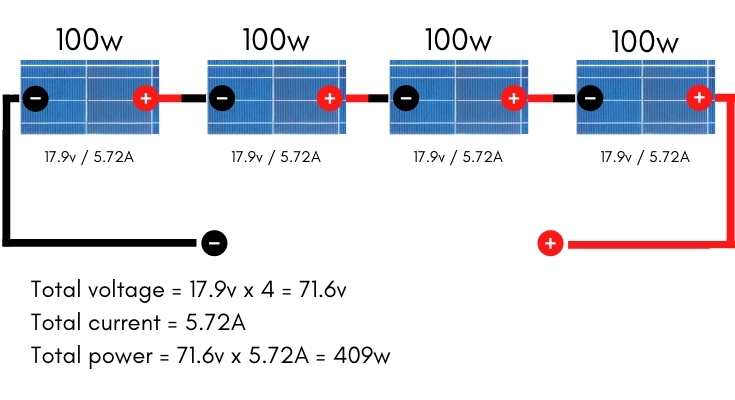
In the diagram above, 4 x 100w panels, each with a rated voltage of 17.9 and current of 5.72A, wired in series could produce 71.6 volts and 5.72 amps – a total of 409 watts.
Note, solar panels’ wattage is rated under standard test conditions. So, for example, these 100w panels will provide 100w then but slightly more in colder temperatures.
Solar Panels Wired in Parallel
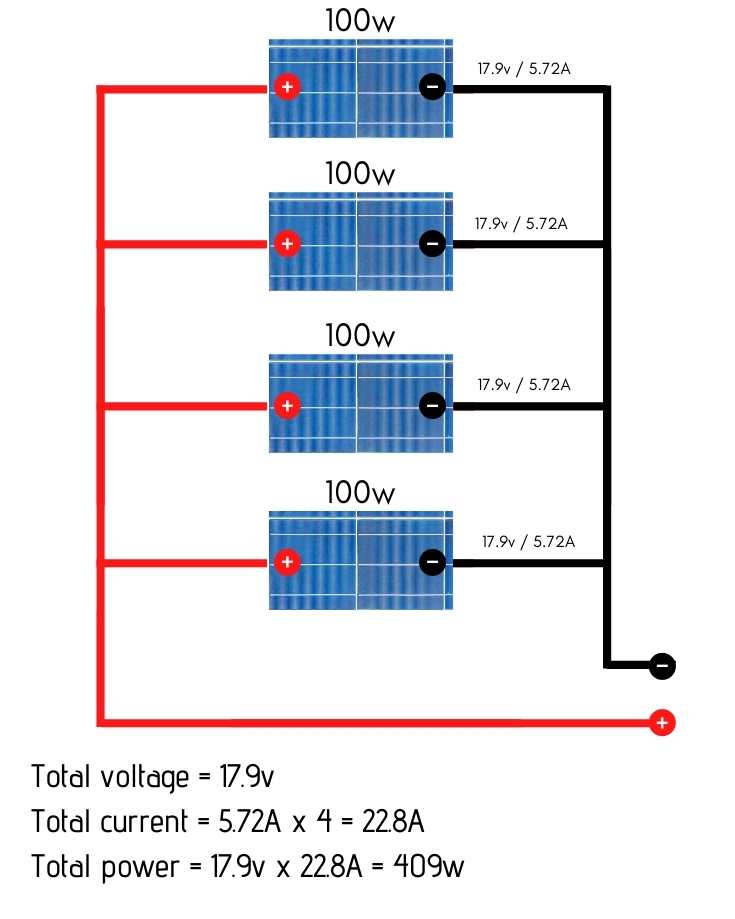
A parallel connection is created when the positive terminal of one panel is connected to the positive terminal of another, and the negative terminals are connected to each other.
The connections are made with branch connectors.
When solar panels are wired in parallel, the array’s voltage stays the same while the current (or amps) are added together.
In the diagram above, 4 x 100w panels, each with a rated voltage of 17.9 and current of 5.72A, wired in parallel could produce 17.9 volts and 22.8 amps – a total of 409 watts.
Solar Panels Wired in a Combination of Series & Parallel
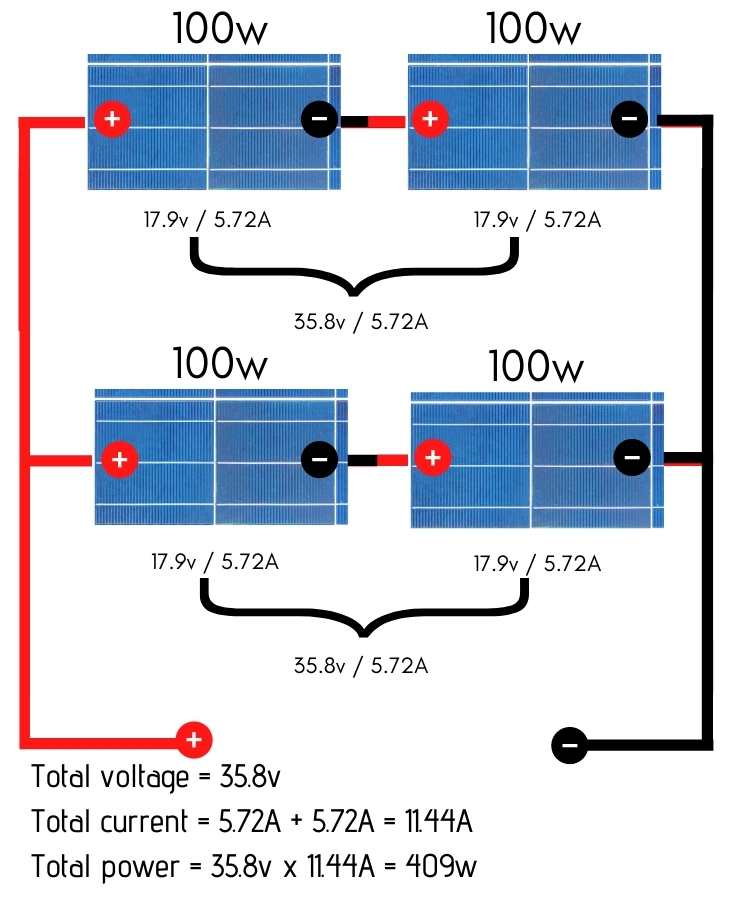
There are no surprises for figuring out what wiring solar panels in a combination of series and parallel means.
Taking the same 4 x 100 watt panels, you’d wire a pair in one string (i.e. in series), the 2nd pair in another string, then wire the two strings in parallel.
When solar panels are wired in a combination of series and parallel, the voltage in each string is added together while the current (or amps) stays the same.
Then, the two strings’ voltage stays the same while the current (or amps) are added together.
In the diagram above, 4 x 100w panels, each with a rated voltage of 17.9 and current of 5.72A:
- The 1st pair of panels wired in series could produce 35.8 volts and 5.72 amps
- The 2nd pair of panels wired in series could produce 35.8 volts and 5.72 amps
- These two strings wired in parallel could produce 35.8 volts and 11.44 amps – a total of 409 watts.
When the solar panels in the array are all the same, the power output is the same regardless of how they are wired (at least mathematically), but the current and voltage differ.
It’s important when it comes to selecting a solar charge controller for your RV camper.
But there are two caveats to all of this.
- Firstly, the calculations only hold when all the solar panels in the array are the same.
- Secondly, the power output calculations are based on optimal operating conditions.
Is Wiring Solar Panels in Series vs. Parallel Best?
Solar panels can be configured in two primary ways: in series or parallel.
The series configuration increases voltage and is particularly beneficial under varying light conditions.
The parallel setup boosts current, optimizing power output when sunlight is abundant.
However, each comes with challenges and benefits, from handling shade to compatibility with different panel types and sizes.
The choice between series and parallel isn’t black-and-white.
Factors such as shading and the specific characteristics of your panels all come into play.
For instance, while series wiring can extend battery charging times, it may require a larger and more expensive charge controller.
On the other hand, parallel wiring reduces the impact of shading and allows for easier panel replacement but might involve a more complex installation process.
Now, if you’re eager to delve deeper into the intricacies of solar panel wiring and how to maximize efficiency, we have an in-depth article that explores these configurations in detail.
It provides valuable insights into balancing voltage and power output loss, dealing with real-world conditions like shade and temperature variations, and much more.
Dealing With Mismatched Solar Panels
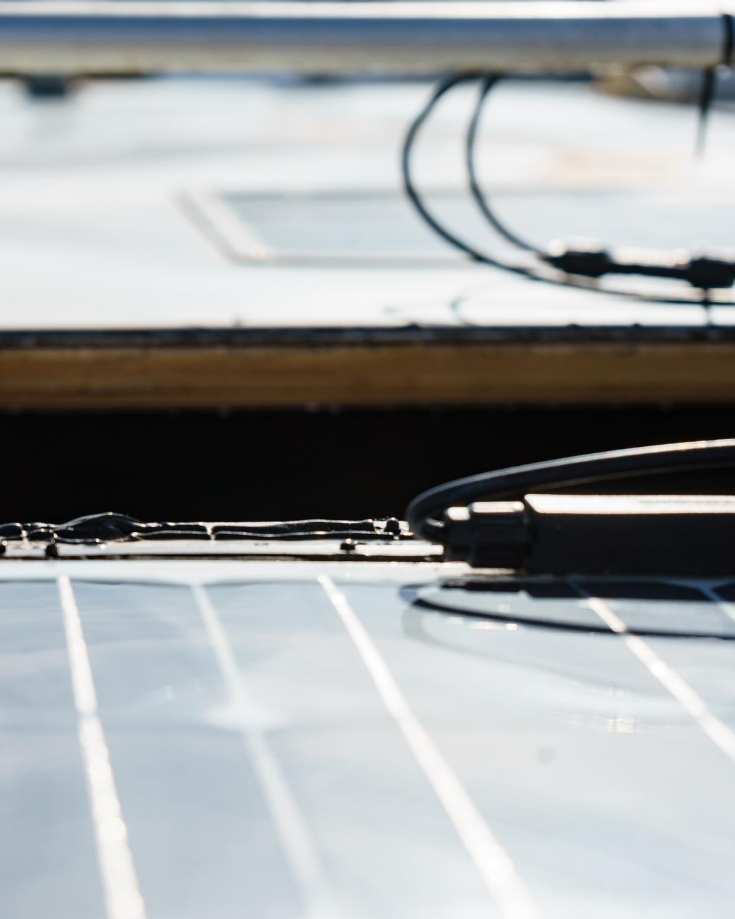
When dealing with mismatched solar panels, the wiring configuration plays a significant role in determining the efficiency of your solar array.
Whether you choose to wire your panels in series, parallel, or a hybrid of both, each method has advantages and potential drawbacks.
For instance, while series wiring boosts voltage, it matches the lowest amperage.
On the other hand, parallel wiring enhances the current but matches the lowest voltage.
It’s crucial to match voltage and current as closely as possible when mixing different solar panel brands, types, or wattages.
Mismatched panels could lead to significant power loss, irrespective of the wiring configuration.
However, you can mitigate this by separating different solar panels into arrays with no mismatched panels, each with a dedicated solar charge controller.
Now, if you’re interested in finding out more, check out our comprehensive information about dealing with mixing solar panels.
This guide will equip you with the knowledge to make informed decisions about your solar setup.
Automatically Create Your Bespoke RV Wiring Diagram
Includes 110v & 240v, solar, B2B, batteries, inverters, 12v, 24v & 48v systems, wire gauges in AWG & mm² & much more!
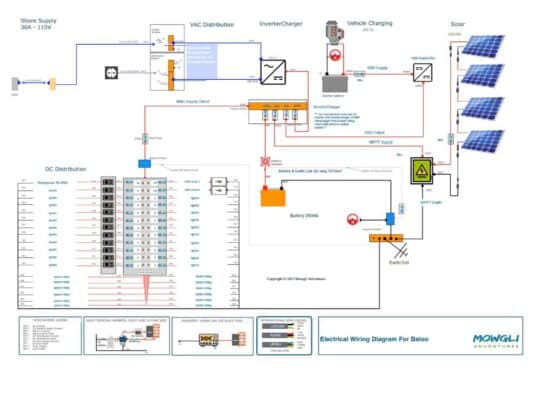
In Conclusion
We aim to get the best combination of watts (power out) and voltage to spend more time off-grid and make our batteries last longer.
The intricate world of solar panel wiring offers a myriad of possibilities, each with its unique blend of advantages and challenges.
Whether you opt for series wiring, parallel, or a combination of both, depends largely on your specific circumstances – the type and number of panels you have, the characteristics of your installation site, and your energy needs.
Remember, while the process may seem daunting, the key to maximizing the efficiency of your solar array lies in understanding these fundamental concepts and making informed decisions.
Graham Bogie

Graham is a seasoned marine electrical engineer with two decades of experience designing customized electrical systems for plant machinery and converting campers and overland vehicles. His expertise has led him to author the reputable Campervan Electrics Handbook and become the chief designer of the RV Wiring Design Tool. As a knowledgeable figure in the field, his YouTube channel, blog, Facebook group, and newsletter, offering electrical advice and product reviews, reach more than a million users each year.

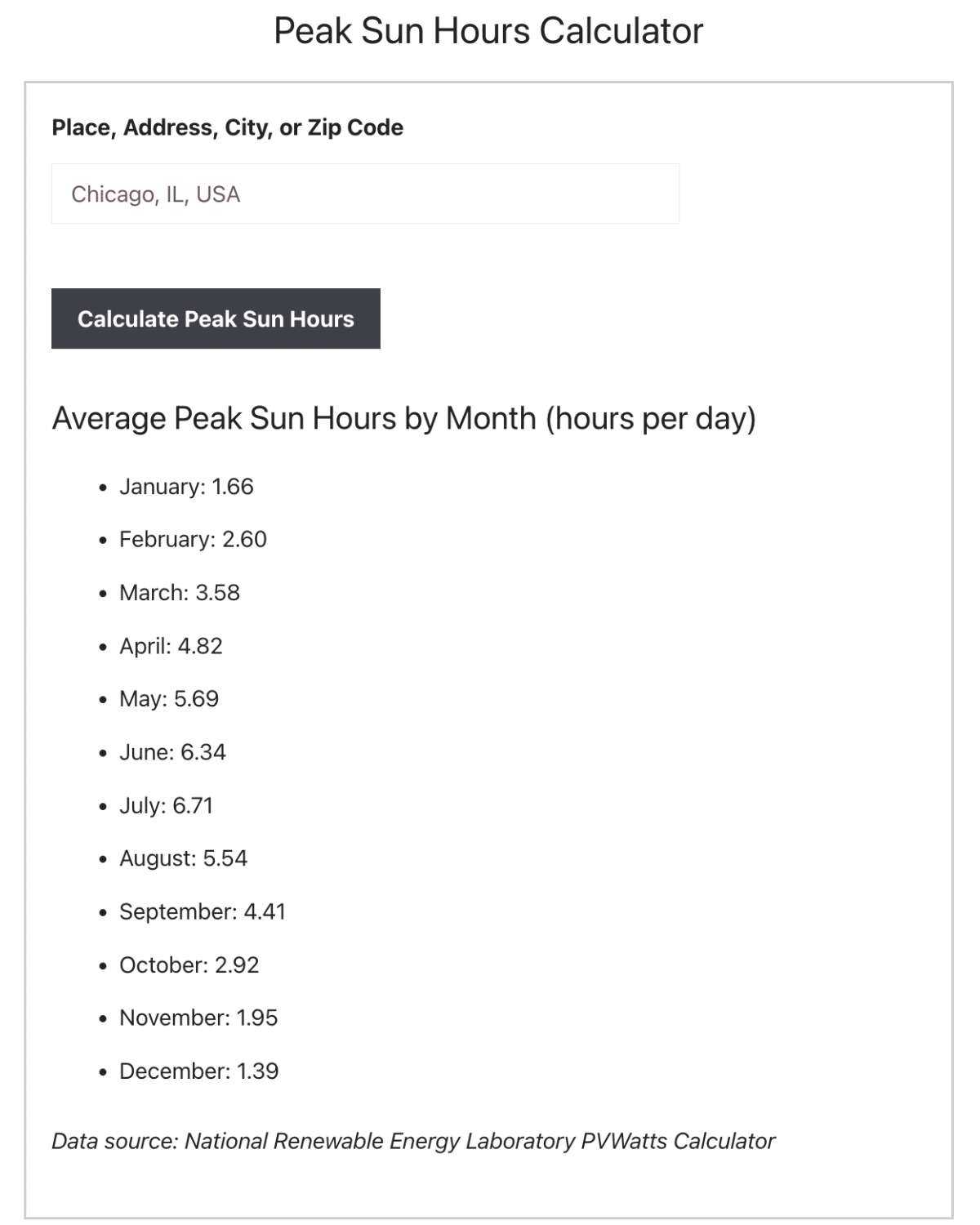
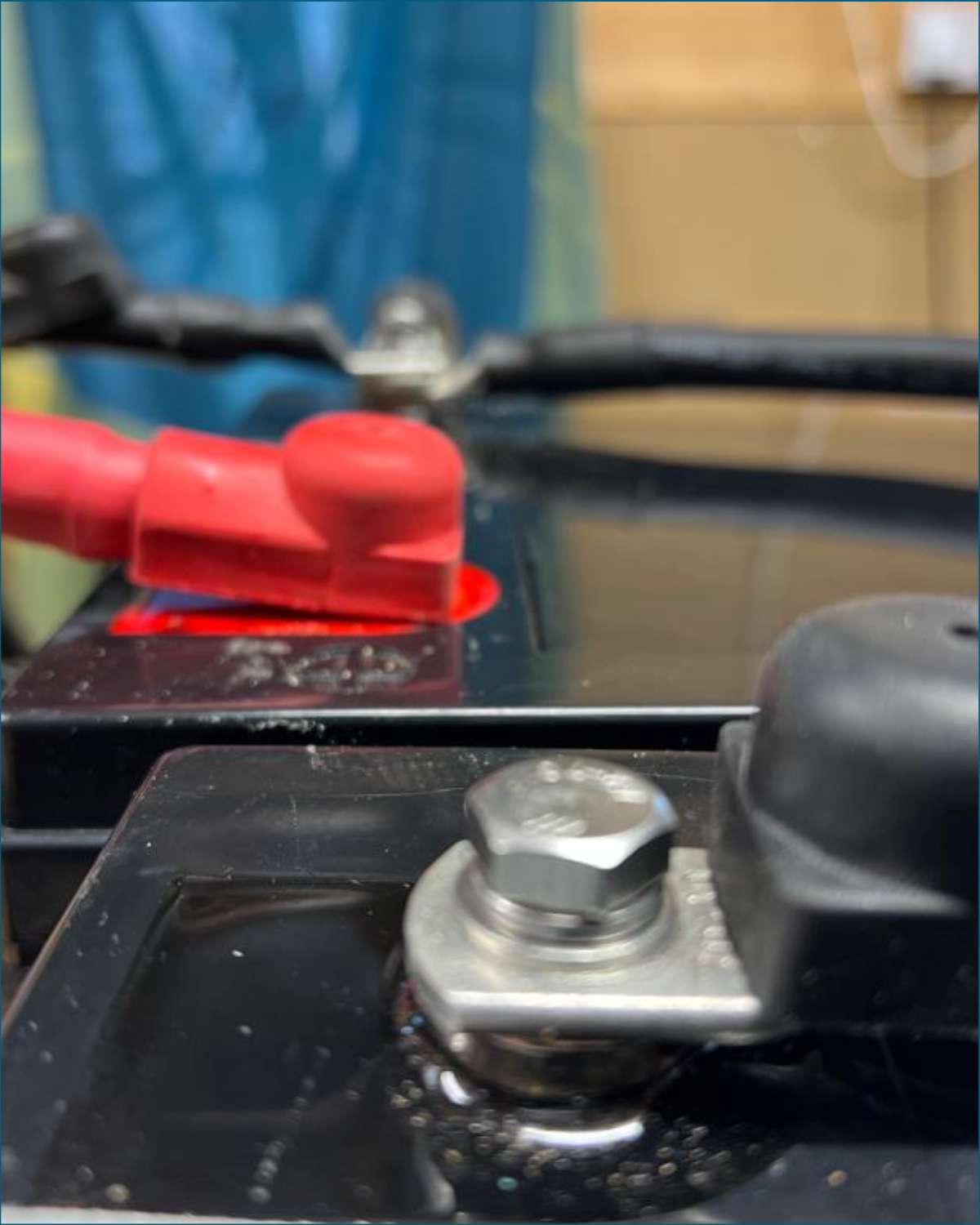

Or buy 24v panels and wire in parallel, getting the best of both worlds.
Enjoy,
Hi,
Really great write up, and so helpful!
I have a quick question,
I have 2 similar sets of panels from Renogy, all are 100W panels but 3 of them are an updated design and 2 are older, so their specs vary slightly, they ship both designs randomly.
My setup is as follows:
2x Older Design Spec VMP 18.6V – IMP 5.38A
3x Newer Design Spec VMP 20.4 – IMP 4.91A
Using your calculator it suggests the best outcome possible by my 100/30 MPPT is to wire in parallel and then link in series, my question is how do I do this please?
I have tried searching everywhere online, but I cannot find an explanation to wire Parallel-Series, only how to link Series-Parallel
Thank you!
To add to my previous comment, I have 2x 18.6v 5.38a 100W panels and 3x 20.4v 4.91a 100W panels, for some reason renogy seem to randomly ship 2 different variants of their 100W panels.
The calculator suggest best mixed config is parallel-series, but for the life of me, I cannot find any diagrams or write ups online of how to wire this up with my panels.
Any help or pointers would be hugely appreciated!
Thanks a lot!
Great write up, and love the calculator, thank you so much!
1 question though, how would I configure
“Each spec wired in Parallel, then all wired together in Series”
I know how to wire Series-Parallel, just not sure on Parallel-Series.
Any advise would be greatly appreciated!
Pensioner newbie to PV. I like your website and so will jump in for some advice. Not a camper so I hope that’s OK. I have been working on my 24V DIY system since spring. 2 – ground racks of 3 – 24V, 320W, 40V, 10A. These are wired in series (with a common neutral at combiner) and then come together at a 3rd combiner.
This is a work in progress.
At recent temps of around 25C I’ve been getting about 110V at peak sun. So I think I’ll be OK in cold weather for my Flexmax80 150V. I’ve put up 3 more identical panels on a south facing wall and ran your calculation (which btw is awesome) It looks like I will exceed the wattage spec for the FM80. I can just disconnect them in winter but I’m looking for a plan B to get the most from my Outback 3.5K Inverter. I’m leaning towards an additional (albeit smaller charger)to run panels 7,8,9 through (and this sounds fairly complicated).
Have 4 12V 2.1kWh batteries.
I’ll be much obliged for any input.
PS: central NH 43rd latitude. We get some cold up here.
On the solar panel specifications, which volts do you use? (STC Short Circuit Current, Open Circuit Volage, Current at MPP, Voltage at MPP. Then these are repeated with NMOT)
i’ve got 4x200w renogy panels and am trying to decide the best way to go for controllers. Add two maxxfans on the roof and I don’t think I’ll be expanding this array, and am thinking I’ll be going Series Paralel. Would one controller or two controllers be better?
Hi and thank you so much for clearing so much up for me .i have three panels of 80 w , two of which are different to the smaller one but all produce near enough the same power and this is the first time i have tried to do something like this . we have only had the van a few months but i am really enjoyind working on it and making improvement …… well i call them improvements . i do have a question for you , have you ever heard of anyone making a ventilator using an old radiator fan from a car ?
thank you once again , safe trips Martin
Hi this is a great article!
Sugestions:
I have:
7 100w renogy solar panels
1 60A renogy Rover PG MPPT Charge Controller
10 6v 210AH batteries
1 3000w renogy inverter
I am using for keep my refrigerartor 24/7 and i have the batteries wirring at 12v and panels in parallel.any sugestions for this set up. Thanks!
Hi Guys.
A couple of your responses seem to me to conflict and therefore confuse me. These 2 responses you gave are:-
1. The main point to take from this is that mixed configs can give as about as much power as parallel in lab conditions – the remainder of the info in the post about real world use should then help further inform your installation decision.
2. The upshot is, to get the maximum output from identical panels don’t split the configuration. Wire them all in parallel or all in series. Which of those you choose should be determined by the other factors explained in the post. I hope this helps but let me know if you have more questions. Graham
The first reply says mixed configs can give about the same power as parallel while your second reply says don’t split (mix) the config. This seems to conflict. What am I missing? Thanks.
Hi Manfred
Point 1 is about dissimilar panels. JB gave us his panel specifications and identified different results based on how he entered in his dissimilar panels in the calculator. He has a 120W panel (17.5V, 6.98A) and 2 60W panels (17.5V, 3.49A) and there are 4 different ways to install. All in series, All in parallel, 2 smaller in series and then in parallel with larger single or 2 smaller in parallel and then in series with the larger. What we are saying is the power output of putting all the panels in parallel will generate as much energy as putting them 2 in series then in parallel with the larger panel, which is a poor outcome. The best energy outcome for this scenario is 2 small panels in parallel then in series with the larger panel.
In point 2 we are discussing the best way to handle similar panels.
I hope that helps clarify.
Regards
Hi there. I am trying to make use of 1 dissimilar panel in my solar array. I have 3 panels 175w 17.9v 9.8amp. And 1 165w 18.9v 8.8amp. Total 690w
The wiring in my rv is only 10g from the roof to charge controller so I need to keep the amperage under 30 amps so unable to wire all in parallel.
I was thinking of wiring 2 and 2 in series and then those pairs in parallel.. I used you calculator and it suggests a large power loss. Are my calculations correct?
Series#1 2x 175w 17.9v 9.8amp = 35.8V 9.8 amps
Series #2 1-175w 17.9v 9.8amp + 1-165w 18.9v 8.8amp
= 36.8V 8.8amp(using lowest amperage)
So series #1 35.8V 9.8 amp and #2 36.5v 8.8 amp in parallel Would
= 35.8V (lowest voltage) x 18.6 amps to charge controller
666w
690w to 666w = 3.5% loss.
Does this sound correct?
Hi
Yeah that sounds about right. Alternatively, you could wire the 3 like panels in series (so still keep the amperage down) and connect the 4th panel to a separate solar controller. It’d add an extra cost but you could eeek out another ~50w and your overall losses would be almost nothing.
Hope that helps :-)
So, you’re wiring panels in series (71 Volts) onto a 12 volt battery? Did I read that correctly?
Hi Jim, You did. We’re wiring solar panels to a 12v battery bank via an MPPT controller. The controller does the clever stuff of regulating the voltage to what the battery can accept. The spec of the MPPT will tell you the max input voltage it can take from the panels. It’ll then convert that down to 12-14v to charge the battery (depending on the battery’s charging profile). I hope that helps :-)
…or to connect 2 in parallel and one in series after?Which is better?
THANK YOU !!!
Hi Al,
Have you plugged your numbers into the calculator near the top of the post? As all your panels are identical, you won’t gain/lose anything when wired all in series or all in parallel. If you want to use the calculator to test different configurations, spilt the 3 panels across 2 rows in the calculator. By entering 2 panels on one row and the 3rd panel on its own, see the effect (you’ll effectively lose a panel). The upshot is, to get the maximum output from identical panels don’t split the configuration. Wire them all in parallel or all in series. Which of those you choose should be determined by the other factors explained in the post. I hope this helps but let me know if you have more questions. Graham
@Angela and Graham,
THANK YOU FOR YOUR HELP !!!!
Your website is great. Full of useful info.
I’ll might hang on a while here. :)))
Thanks again.
Al
Hi everyone,
I have a question:
I have 3 x 100W 21V 5.72A Renogy panels.
Could anyone tell me the data if I connect to in series (to raise the voltage) and one in parallel? How many volts and ampers I will have at the end?
Is it doable?
Thank you.
Thank you! I’m buying some new components and moving some existing components around and this article was key to helping me realize that I was under-utilizing my MPPT.
In our current setup we have a small caravan with only one portable 100w panel (it came with a small pwm controller built-in which can be bypassed) which seems plenty. It has a 100Ah battery for lights, charging phones, and a ventilation fan for the hottest parts of the day. I installed a 20A MPPT here for future expansion that will not be needed.
Our new larger caravan has 225Ah battery and a single 100w panel from the factory along with 10g wiring from the gland to the battery from the factory. It has a dismal 10A PWM controller. I’m learning that adding 200w to this trailer in series with the existing 100w is doable and actually a better setup since I’ll be using more of those volts to charge more throughout the day. A calculated loss of 1% from mixing slightly different panels is more than acceptable to me. It seems my wiring is also plenty robust since I’m adding volts not amps (series wiring). I’m moving the MPPT from our smaller caravan to the larger one take advantage of this electrical curiosity.
We’re so pleased the article helped you figure it out and get the best out of your kit! Enjoy.
Useful and clear article but I don’t think the calculator is working properly.
I put in a 120W panel (17.5V, 6.98A) and 2 60W panels (17.5V, 3.49A). The calculator gives different answers for mixed configuration of series and parallel depending on how you enter the 60W panel details into the calculator.
Putting the 60W panels in once with a quantity of 2 gives 17.5V, 10A, 175W and 28% loss.
Entering the 60W panels twice each with a quantity of 1 gives 17.5V, 14A, 245W and 0% loss.
If you put any of the panels in series the voltage has to be at least 35V.
I believe the answer should be, you put the 2 60W panels in parallel to get 17.5V, 6.98A and then put the 120W in series with them giving, 35V, 6.98A and power of 241.5W.
Hi Jeremy. Let me start by thanking you for your feedback. We’ve spent a few hours going through your comment and the calculator and finally figured out where the confusion has come from. The calculator was set up to work out the total power when each panel spec is wired in a dedicated (series) string, then each of those strings wired together in parallel.
So, your first point regarding the different calculation results when you enter the same panel spec but on 2 different rows is because the calculator assumes these would each be in their own series. Entering the exact same panel on 2 different rows basically had you calculate for a parallel configuration. I’ve further stressed the importance to the calculator of using only one line per spec.
That said, you were also right in that wiring the 2 small panels in parallel then in series to the larger panel would give you a better outcome as a mixed config compared to putting the 2 in series then in parallel to the larger panel. The total is about the same as wiring them all in parallel. However, we felt the post wasn’t clear on that point so spent a few hours updating the calculator to output the 2 different types of mixed configuration.
Now the calculator works out the power for all in series, all in parallel, each spec type in series then all those wired in parallel and finally, each spec type in parallel then all those wired in series.
There’s a bit rounding going on within the calculation but that’s all much of a muchness.
The main point to take from this is that mixed configs can give as about as much power as parallel in lab conditions – the remainder of the info in the post about real world use should then help further inform your installation decision.
Thanks again for your feedback and I hope this has fully addressed your point.
Has anyone designed a simple switch to switch the panels back and forth from Parallel to Series as the conditions warrant?
i have 5 100 watt panels in parallel
my mppt only shows at the most in full sun
18v 7 amps
why does it only show that
Hi Allen. Mmm this doesn’t seem right. You should be kicking out a lot more than that. It sounds as though maybe only 1 panel is connected. Are they rigid panels? Check they have a good air gap below them. Disconnect them all then test each one individually with a multimeter. As you reconnect each panel (in parallel) in turn, check the MPPT readings are increasing in line with expectations. Check this as you reconnect every panel to try to find the problem. Let us know how you get on.
Great relevant article!
Do you know what the effect is if two panels are in parallel and:
1)one is fixed at 30 degrees on the roof (Land Rover Series), then another is removable and lies flat.
2) If I remove the one panel and aim it optimally on the ground, while the fixed one is still at an angle.
Would the differing amps just be a simple addition calculation? or something more complex?
Hi Corlius
Any panel directed towards the sun will perform better than if it were flat. If you wired in series, the improved performance of one panel would be dragged down by the other panel. That’s not the case when wired in parallel. So the upshot is, if you plan to have 2 panels mounted differently from each other, you get a better result when wired in parallel. But, it’s still worth testing that out over the course of an entire day. With more hours charging, even at a lower rate, you may end up better off in series. Hope that helps answer the questions – I can’t be precise about angle of mount because of the location of the sun in the sky during the day, year round and your location.
Regards
Graham
Hi,
I am a newbie to all this so really hope you can help as been looking for answers everywhere. I have 2x 100w panels and am going to buy a Victron smart solar charge controller 100/20 and i have 110ah leisure battery which is already getting charge by main motorhome battery. what i wanted to know is i was going to use 4mm2 cable from panels to controller but wanted to put a fuse between them so what size fuse do i need? also going to do the same from controller to leisure battery but have 6mm2 cable so what size fuse for that cable? One more thing would the charge controller charge the main motorhome battery as well as the leisure battery? Thanks Dave
Hi David,
Solar panel cable is a standard 10AWG/6mm² so it’s probably best to stick to that size. The 2 100w panels will give around 8a if wired in series, 16 if wired in parallel. Therefore the fuse should be 10a for a series configuration and 20a for a parallel setup.
The charge controller will only output 20a (that’s what the spec says) so you need a 20a fuse between the controller and the battery bank.
If you have a dual sensing VSR or B2B, then the starter battery will get a top up from the charge controller once the leisure batteries are full.
I hope this helps and I recommend getting a copy fo the Campervan Electrics Handbook to help build your knowledge.
Regards
Angela
New to all of this and trying to figure out what is best for my needs to maximize my daily charging
I have 40amp mppt with 4 100 watt panels
Connected to 4 100ah agm batteries.
Right now i have them wired in parrellel series
Hi Dennis I’m assuming you mean you have 2 strings in parallel with each other. The calculator should give you a good idea. Our system isn’t far off your own and we found it more efficient when all panels are in series. Reconfiguring them only take a few minutes if you’ve got all the right adaptors. When we changed ours we knew within a few hours we’d hit the proverbial jackpot. Let us know how you get on. Graham
Hi,
this is a very interesting and informative read thank you, I was totally unaware that the panels could be wired in series!!
I am considering increasing my solar from 100w (with PWM) to 300w (2 x 150w with MPPT) on my motorhome but using the existing electrical system. The system includes dedicated 4mm2 cable through a 20amp fuse on the distribution board which is more than adequate for the 100w panel. However Im unsure if the system could handle 2 x 150w in series due to the higher voltage of 36v??
My other option is to wire direct to my batteries which is not recommended by the manufacturer but has been done by others with no adverse affects!
Your advice would be very much appreciated.
Kind regards
Chris
Hi Chris Moving up in panel size will give an increase in voltage as you say, but the current will remain similar or slightly higher than your current 100w panel. We reckon probably around 15 amps. So we would recommend, wiring in series and connect to your distribution panel as is. Let us know how you get on.
What about using some type voltage regulator on the panels so it’s always above 12.6 volts?
Hi Craig – A solar charge controller does the job of regulating the voltage as you’ve described. An MPPT is more efficient than a PWM but either way, it works with the voltage received from the panels. How the panels are wired affects the voltage the charge controller receives.
Great article & much appreciated.
I am excited to get my panels numbers & plug them into your calculator.
Thanks Larry, glad you found it helpful!
Thanks for putting this article and calculator up.
I put the question you answered (can you mix panels and series / parallel wiring successfully?) on multiple forums and had wildly different answers. Your calculator and comments were spot on allowing me to expand my system without spending the dollars to reinvent everything. Thank you.
Brilliant! So glad this helped! We see so many opinions too and often it comes down to a combination of what is technically possible and how that fits with how you’ll use the van. Comparing things like this before we made the final decision helped us put it all in perspective.